The Huawei MateBook 16 Review, Powered by AMD Ryzen 7 5800H: Ecosystem Plus
by Dr. Ian Cutress on October 20, 2021 8:00 AM EST- Posted in
- Laptops
- AMD
- Huawei
- Matebook
- Ryzen
- Zen 3
- MateBook 16
- Huawei Share
- Ryzen 7 5800H
Display, Battery Life, and Charging
The Monitor
The high-level specifications of the monitor make for very interesting reading. A 16-inch IPS display with a 2520x1680 resolution, making it a 3:2 ratio (which is becoming more and more common on laptops of all sizes). The IPS panel means that the viewing angles are wide, and Huawei rates the screen for 300 nits brightness maximum as well as a 1500:1 contrast ratio. That brightness maximum isn’t anything to write home about – in fact it’s a bit low for any external daytime use – but the contrast ratio is better than the MateBook X Pro we last reviewed because of the lower blacks. On colors, Huawei pre-calibrates the display to a dE below 1, qualifying the display for 100% of the sRGB gamut with 8-bit + FRC support.
That gives a lot to play with, so here are our results:
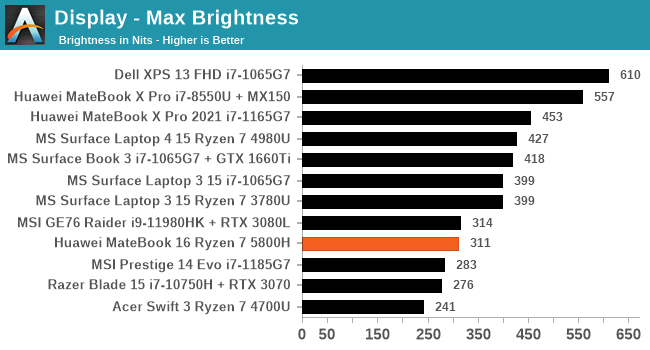
The specification sheet said 300 nits, and we scored 311. Our 200 nits regular battery testing was at a brightness setting of 65, with a very linear profile sweep.
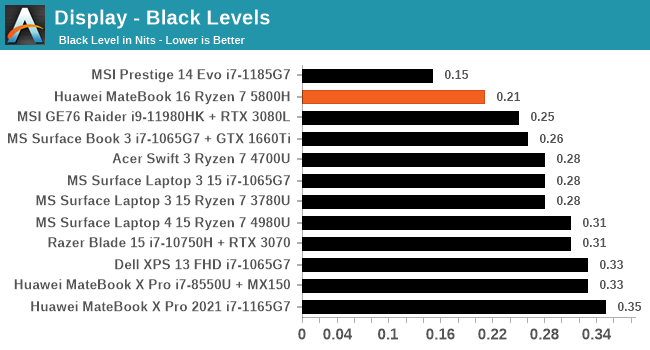

The display has some of the better black levels at maximum brightness that we’ve tested, giving a 1488:1 contrast ratio, which is almost identical to the rating.
The odd resolution of 2520x1680 is a little left-field: Huawei calls it a 2.5K+ display. But what it really comes down to is the 3:2 version of 2560x1600, which is a 16:10 ratio. The only thing really missing from the display is the lack of a touchscreen. For certain office workloads, having a touchscreen is quite handy, although it does tend to add a little weight.
For those looking for color accuracy, unfortunately I do not have the same equipment Brett does for this, however my colorimeter provides the following at 200 nits:
This shows that the red tracking is almost perfect, with the greens and the blues being biased away from that proportional line.
Battery Life
Due to the short time we had, I was only able to run one battery life test, and chose our Web Playback test that uses MS Edge to cycle through a number of remote server-driven but fixed webpage workloads. The screen brightness is set to 200 nits. Power numbers are reverse calculated mWh reported by Windows.
After the initial caching of the webpages, the system settled down into a 6-8 for most of the test. At around 550 minutes, we see a decrease in the system activity, which we’re attributing to the system entering the low power plan at 20% total battery, which surprisingly picks up again after an hour around 15% battery. The total battery life in this case, from 100% charge to shutdown (which this laptop was set at 2%, but Windows cuts at 2.5%) is 697 minutes.
Charging
So here’s where it gets a bit interesting. The laptop has a 35W/45W processor, an 84 Wh battery, and a 135 W power charger. The performance mode can only be accessed when the charger is equipped. But in a charging scenario, we get three different variants:
- When the system is idle, it will charge the battery at around 35 W and draw 50 W at the wall.
- If the display is closed, regardless of the sleep state, the battery will charge at 70 W and draw 70-90 W at the wall.
- Only when performance mode is active, and the CPU is being used fully, does the charger draw its full 135W setting.
One of the key features of this unit is the fast charging and the bundled 135 W charger. But users should note that it never charges at 135 W, but it will draw that much at the wall when the system is in use under a high-performance load. We did charging runs for both the first and second modes, with the display set to 200 nits but otherwise the system was idle.
In the 70W charging mode, the system charges at 70 W for 42 minutes, before dropping to 60 W for 8 minutes, then trickling down until ~82 minutes where it ramps up again for a seemingly final push. In this mode, we get the following:
- 10 minutes charge gets from 1696 to 13466 mWh (15.8%)
- 30 minutes charge gets from 1696 to 36374 mWh (42.8%)
- 90% charge takes 71.3 minutes
When we move down to the 35W mode, while the system is in the default Balanced CPU mode rather than Performance CPU mode, it takes a lot longer:
Here we start with an initial power wobble (for whatever reason this laptop doesn’t like accurately refreshing its battery power below 5%), and then get a constant 35 W battery charge until 90%, then it switches charging modes until 95%, and the PMIC increases charging again. In this mode, we get the following:
- 10 minutes charge gets from 1662 to 5925 mWh (7.1%)
- 30 minutes charge gets from 1662 to 17408 mWh (20.9%)
- 90% charge takes 130.2 minutes
I can certainly see the reason for having a slower charge while the lid is up – if there would be a thermal build-up on charging, the lid up means that while the laptop is in use, and so the user is not affected. It also gives room for when the system needs to go full bore. The downside is knowing that shutting the lid doubles the charging rate, so if you need a quick charge before going somewhere, it’s going to be beneficial to close the laptop lid and wait, unable to use the device, than to continue charging and working.

It should be noted that when our review unit arrived, the 135 W charger was effectively DoA; a second one arrived the day before our review embargo lifted (I unfortunately went on holiday, so this review was completed after I returned). That second charger has worked flawlessly, so I can only assume we had a (rare) dud charger. During the interim, I had other Huawei 65 W chargers from other products around for testing, and those worked without issue.


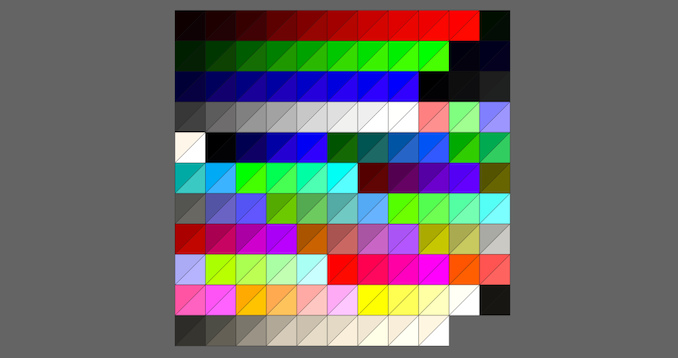
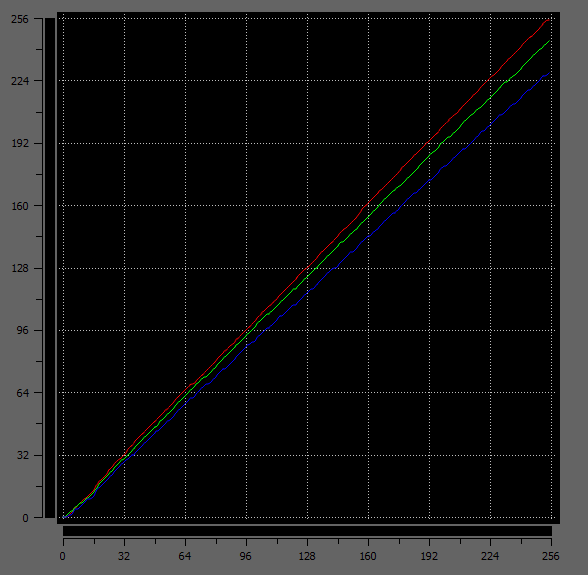
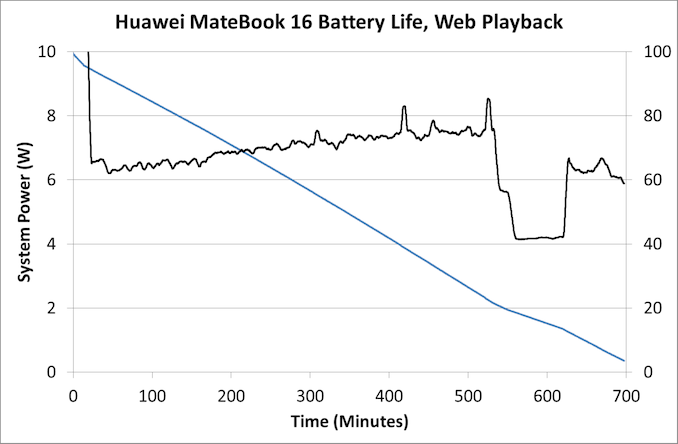

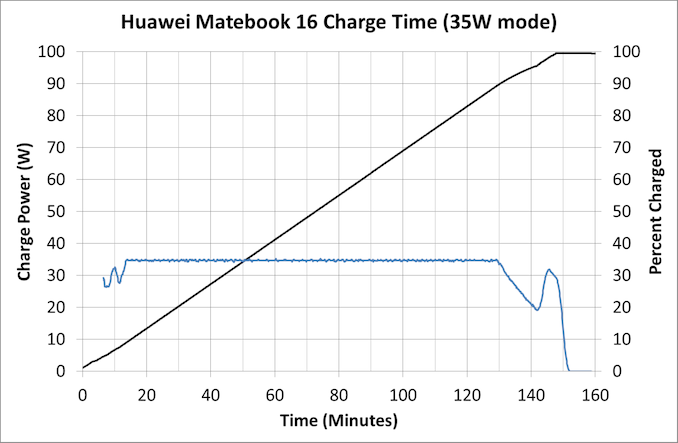








87 Comments
View All Comments
EasyListening - Friday, October 22, 2021 - link
You are asking for such a thing while supply chains are completely screwed.GreenReaper - Saturday, October 23, 2021 - link
If you don't ask, you never get.abufrejoval - Wednesday, October 20, 2021 - link
I also see the lack of RAM expandability as the key issue.I have a Lenovo Slim 7 13ACN05 and with all eight cores at 15 Watts it's not really able to pull ahead of a quad core Tiger Lake i7-1165G7 NUC I operate at the same Wattage in 'normal' workloads (say compile jobs, Ansible scripts, juggling VMs etc.), because it needs to downclock too much to sustain the 15 Watt power envelope. It's also maxed out at 16GB for RAM, even a single soldered module seems impossible with an Ultrabook form factor.
64GB in two SO-DIMMs make the NUC quite reasonable machines for light server workloads and I'd sure pay a little extra to include a "KVM", a "UPS" etc. to make it a notebook like this.
At 35-65 Watts an octa Ryzen really pulls ahead of all things Intel quad or hexa in the same wattage rage, but without RAM to expand it's all for naught. With this chassis size replacable RAM should be no issue so it's really sad they go "Apple" there.
While the Tiger Lake Xe 96 EU and Vega 8 iGPUs at 50GB/s offer impressive improvements over plain old "HD", Iris Plus or Kaveri, machine learning and gaming just require completely different classes of hardware, so I'd be happy to sacrifice a bit of DRAM bandwidth and latency for capacity in such a machine.
The Lenovo puts a Windows Hello compatible Webcam in such a small frame on the 16:10 2560x1600 display, I really don't see the point of a snot-cam.
dontlistentome - Wednesday, October 20, 2021 - link
Think yourself lucky you get the option of 16GB, in the UK they only sell the 8GB models.abufrejoval - Thursday, October 21, 2021 - link
I do feel lucky to have the device, because it's generally a well built marvel.But Lenovo is also lucky to have at least offered 16GB, because at 8GB they would have lost that sale for sure.
But I surely would have paid 200% RAM market price for 32 or 64GB.
anandcx - Wednesday, October 20, 2021 - link
@Ian: You missed the LG Gram 16 in comparison, it weighs just 1.19 KG according to LG but i measured my Gram 16 at 1.15 KG. It has 350 nits screen, better keyboard and touchpad and also costs lesser than the 17 inch version. Honestly it is the best laptop in that segment. Hopefully you can review it and it may even work for your personal use.Prestissimo - Wednesday, October 20, 2021 - link
Matebook seems really overpriced for what they're offering. I'll take LG Gram 17 any day over this as someone who doesn't need power and just want a big screen on my laptop for watching movies and consuming content.If a laptop doesn't have a dGPU and weighs over 1.3 kg / 3 lbs, it's an immediate deal breaker. There is no need for a "Premium Ultrabook" to be that heavy.
TheinsanegamerN - Wednesday, October 20, 2021 - link
Big battery is a plenty good reason.anandcx - Wednesday, October 20, 2021 - link
Gram 16 has 80 Wh battery and weighs 1.1 KG. Gram 17 is 1.3 KG.TheinsanegamerN - Wednesday, October 20, 2021 - link
Gram 17 only has a 72wh batteryhttps://www.lg.com/us/laptops/lg-17Z990-RAAS8U1-ul...
Gram 16 has 80wh battery but cannot sustain high performance due to cooling limitations due to small heatsink and cooling paths. May as well compare a tablet to this machine.